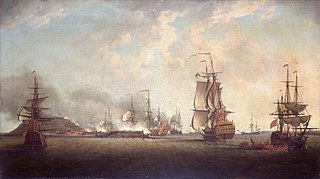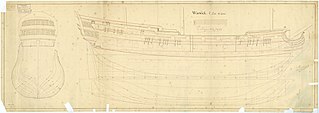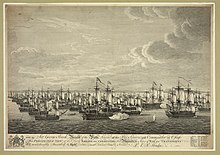HMS Antelope was a 50-gun fourth rate ship of the line of the Royal Navy, launched at Rotherhithe on 13 March 1703. She was rebuilt once during her career, and served in the Seven Years' War and the American Revolutionary War.

HMS Barfleur was a 90-gun second-rate ship of the line of the Royal Navy, designed by Sir Thomas Slade on the lines of the 100-gun ship Royal William, and launched at Chatham Dockyard on 30 July 1768, at a cost of £49,222. In about 1780, she had another eight guns added to her quarterdeck, making her a 98-gun ship; she possessed a crew of approximately 750. Her design class sisters were the Prince George, Princess Royal, and Formidable. She was a ship of long service and many battles.

HMS Royal Oak was a 74-gun third-rate ship of the line of the Royal Navy, built by Jonas Shish at Deptford and launched in 1674. She was one of only three Royal Navy ships to be equipped with the Rupertinoe naval gun. Life aboard her when cruising in the Mediterranean Sea in 1679 is described in the diary of Henry Teonge.

HMS Cambridge was an 80-gun third-rate ship of the line of the Royal Navy, designed by Sir Joseph Allin and built at Deptford Dockyard by Adam Hayes to the draught specified by the 1745 Establishment as amended in 1750, and launched on 21 October 1755.

HMS Neptune was a 90-gun second-rate ship of the line of the Royal Navy. She was built under the 1677 "Thirty Great Ships" Programme and launched in 1683 at Deptford Dockyard.

HMS Captain was a 70-gun third rate built at Woolwich Dockyard in 1677/78. After sitting in Ordinary for ten years she was in active commission for the War of the English Succession fighting at Beachy Head and Barfleur. She was in Ordinary until 1706 when she was rebuilt. She was in active commission for the last half of the War of Spanish Succession but fought in no major engagements. She was at the Battle of Passero I 1718. She was rebuilt in 1720/22. She made two forays in to the Baltic though the bulk of her late career was spent as guardship at Portsmouth. She was hulked in 1740 and finally broken in 1762.
HMS Burford was a 70-gun third rate ship of the line built at Woolwich Dockyard in 1677/79 as part of the Thirty Ships Programme of 1677. She fought in the War of the English Succession, including the Battle of Barfleur, before being rebuilt at Deptford in 1699, remaining as a 70-gun third rate. During the War of Spanish Succession she was mostly in the Mediterranean fleet and fought at the capture of Gibraltar and the Battle of Málaga in 1704 before being extensively repaired between 1710 and 1712 at Portsmouth Dockyard. Burford served in the Baltic in 1715 and 1717 before returning to the Mediterranean to fight the Spanish at the Battle of Cape Passaro in 1718. She was wrecked on the Italian coast in a storm on 14 February 1719.

HMS Eagle was a 70-gun third rate ship of the line of the Royal Navy, built at Portsmouth Dockyard during 1677/79. When completed she was placed in Ordinary for 10 years. She was in active commission during the War of the English Succession partaking in the Battle of Barfleur. She was rebuilt in 1699 at Chatham. She again played an active role in the early part of the War of Spanish Succession participating in the Capture of Gibraltar, and the Battle of Velez Malaga. She was wrecked in the Isles of Scilly in October 1707.

HMS Essex was a 70-gun third rate built by Sir Henry Johnson of Blackwall in 1678/79. During the War of the English Succession she fought in the last major action. She was rebuilt in 1699/1700. During the War of Spanish Succession she fought at Vigo Bay, the Capture of Gibraltar and Velez Malaga. She also fought at the Battle off Passero in 1718. She was rebuilt again in 1736-40. She was in action off Toulon in 1744. She was active in the Channel and against French ports during the Seven Years War. She fought at Quiberon Bay in 1759. She was wrecked in Quiberon Bay in November 1759.

HMS Expedition was a 70-gun third-rate ship of the line built at Portsmouth Dockyard in 1677/79. She was in active commission during the War of the English Succession participating in the battles of Beachy Head and Barfleur. She was rebuilt in 1699. Again, for the War of Spanish Succession she was in commission for the operation at Cadiz then returned to England where she sat for two years. She was in the Mediterranean for the Battle of Marbella in 1705. She then went to the West Indies and fought in Wager's action off Cartagena in 1708. She was rebuilt in 1709-14 to the 1706 Establishment. She spent her time split between the Baltic and as guard ship at Portsmouth before being broken at Portsmouth in 1736. She was rebuilt in 1736/40 at Deptford Dockyard.

HMS Kent was a 70-gun third rate ship of the line built by Sir Henry Johnson of Blackwall in 1677/79. She served during the War of English Succession 1699 to 1697, participating in the Battle of Barfleur. She was rebuilt in 1697/99. She served during the War of Spanish Succession 1702 to 1712 and partook in the Battles of Vigo and Velez-Malaga. She partook in the Battle of Passaro then served during the short war with Spain, December 1718 to February 1720. She was rebuilt in 1722/26. She spent the next thirteen years as a guard ship at Portsmouth. In the 1740s, she was off Cape Finisterre then in the West Indies. She returned home and was finally broken in 1744.

HMS Suffolk was a 70-gun third-rate ship of the line of the Royal Navy, built by contract of 20 February 1678 by Sir Henry Johnson at Blackwall. She participated in the War of the English Succession 1689 - 1697, in the Battles of Beachy Head and Barfleur. She was rebuilt in 1699. She was actively involved in the War of Spanish Succession 1702 - 1713. Her later career was as guard ship duties, deployments to the Baltic Sea and the West Indies. She was finally broken in 1765 after lying in Ordinary for almost twenty years.

HMS Kingston was a 60-gun fourth-rate ship of the line of the Royal Navy, built by Frame in Hull and launched on 13 March 1697. She had an eventful career, taking part in numerous engagements.

HMS Orford was a 70-gun third-rate ship of the line of the Royal Navy, launched at Deptford in 1698. She carried twenty-two 24-pounder guns and four (18-pounder) culverins on the lower deck; twenty-six 12-pounder guns on the upper deck; fourteen (5-pounder) sakers on the quarterdeck and forecastle; and four 3-pounder guns on the poop or roundhouse.

HMS Namur was a 90-gun second rate ship of the line of the Royal Navy, launched at Woolwich Dockyard in 1697.
HMS Norwich was a 50-gun fourth rate ship of the line of the Royal Navy, launched at Deptford on 24 August 1693. The last of seven 50-gun ships ordered during 1692, she was given the name of Norwich following the loss of the previous 50-gun ship of that name on 6 October 1692.

HMS Lion or Lyon was a 60-gun fourth rate ship of the line of the Royal Navy, built at Chatham Dockyard to the 1706 Establishment and launched on 20 January 1709.

HMS Warwick was a 60-gun fourth-rate ship of the line of the Royal Navy, built to the 1719 Establishment at Plymouth by Peirson Lock. The keel was laid down on 1 April 1730, and the ship was launched on 25 October 1733, and completed on 24 August 1734.

HMS Stirling Castle was a 70-gun third rate ship of the line of the Royal Navy, built at Chatham Dockyard to the 1733 proposals of the 1719 Establishment, and launched on 24 April 1742.

Captain Frederick Cornewall was an officer in the British Royal Navy.


















